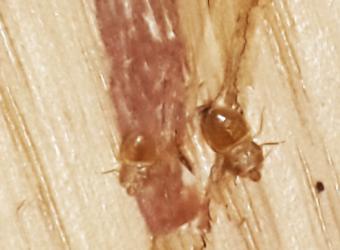
Once you have an infestation, a thorough bed bug treatment is crucial to controlling these bloodsucking insects. Bed bugs can go dormant for up to a year, so treating your home is important.
Before Your Bed Bug Treatment
Avoid the need to administer several treatments by exterminating all the bugs the first time around, if possible. Before you begin the treatment, prepare the infested area to make your efforts more effective.
- Tidy up the area and reduce any clutter in the room. This will make your inspection of the bed bugs easier. Throw away unnecessary papers.
- Prop up the mattresses and take the bed apart. Bed bugs often hide in bed frames.
- Remove all linens and clothing and place them in large bags until they are laundered.
- Caulk around cable and wire holes to stop the bugs' access to hiding places. Caulk around the baseboards, doorframes and moldings, too.
- Vacuum the areas where you find evidence of bed bugs, like carcasses or bloody droppings. Throw away vacuum cleaner bags immediately after vacuuming.
Evidence of Bed Bugs

Use a magnifying glass to find evidence of these itchy bugs in your home. Use these steps to find bed bug evidence:
- Examine your mattresses and look for bug droppings. Bed bug droppings will appear as tiny rusty spots. There may be a few dozen or hundreds lumped together.
- Look in wooden or wicker headboards and footboards. Bed bugs can fit into tiny holes and crevices. You will need a flashlight to see the bugs.
- Remove pictures and examine the backs for bed bugs.
- Look for open seams in the wall paper. Bed bugs may hide there.
- Inspect alarm clocks, phones and any other appliances in the room. Bugs may hide there, too.
After your inspection, the next step is to treat the individual areas of the room, including mattresses and bedroom furniture.
Treating Clothing and Linens
Clean the clothing you bagged by placing it in hot water. The water must reach a minimum of 120 degrees Fahrenheit. After washing, place the clean, dry laundry in new bags and add a strip of DDVP or dichlorovinyl dimethyl phosphate. This insecticide attacks the bugs' nervous system and kills the pests. Leave the clothing and bedding linens bagged with the DDVP strip for two days.
Electrical Appliances
Place your electrical appliances, like laptops or alarm clocks, in a garbage bag and add a DDVP strip. Leave the material bagged for two days. No additional cleaning is needed afterwards.The DDVP strip will not harm your items.
Mattress Cleaning
Vacuum the entire mattress, especially along the folds and seams of the mattress. Do this for the box spring, too. Wear gloves and sprinkle the bed with PyGanic Dust, a botanical insecticide. Seal the mattresses with a mattress cover that is bed bug-certified. Leave the insecticide powder on the mattresses and keep the mattresses covered for at least a year in case hidden bugs go dormant.
Carpets and Baseboards
Vacuum carpets and bare wood floors. Spray the floors with a pressurized, dry insecticide. This will keep floors from retaining a greasy sheen after treatment. Spray under all furniture and inside drawers and closets.
Treating the Body
Unlike ticks, bed bugs do not live in the skin of their human hosts. They feed, hide close by and then return to feed again. However, bed bugs bites can become infected or, at the very least, make you itch. Treat the bug bites to keep the wounds clean and less itchy.
- Shower using water warm/hot water. Use a shower poof and an exfoliating cleanser on your body.
- Rub anti-itch emollient, like steroid cream, on the wounds. Take note of any especially red or white looking welts on your body. These may require a prescription cream like Permethrin from your physician.
Bed bug treatments often have to be repeated because these crafty insects can flatten their bodies and fit in tiny places. If you have an infestation, prepare to spend a lot of time eradicating these bugs.







